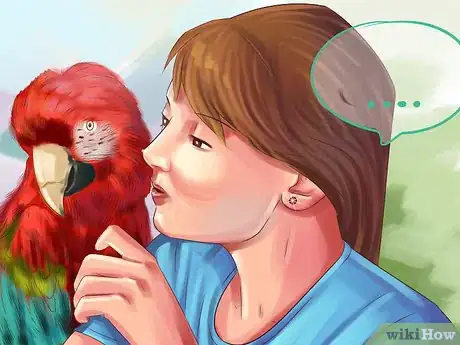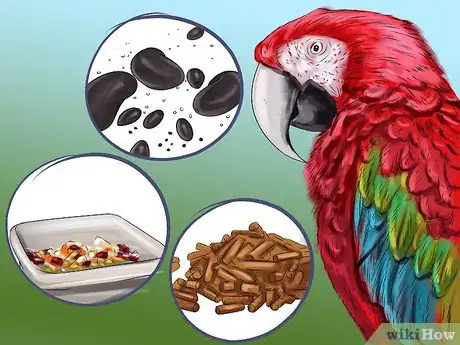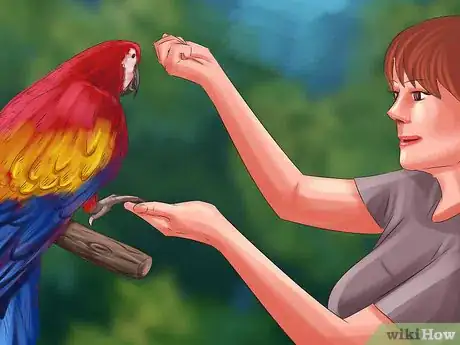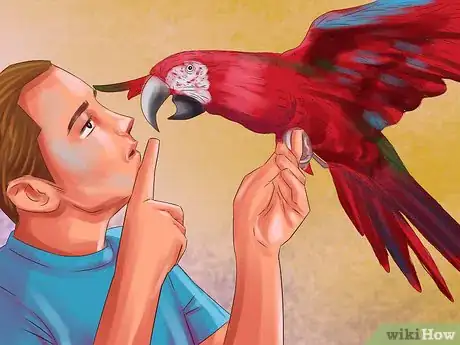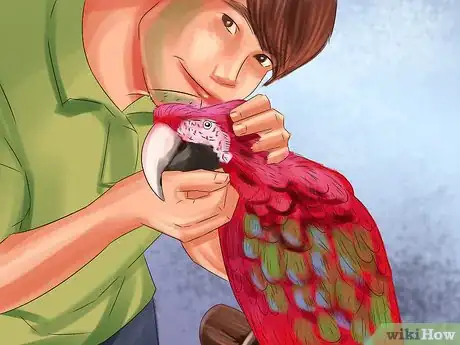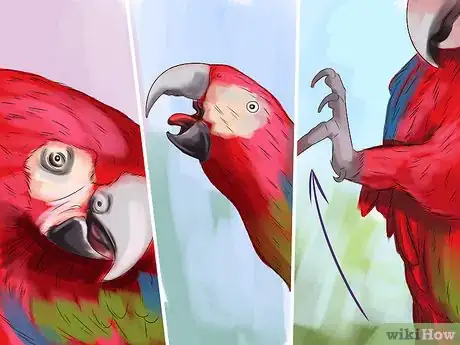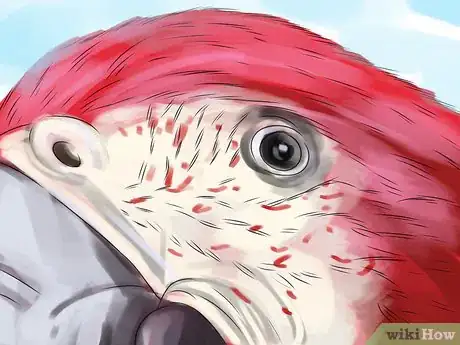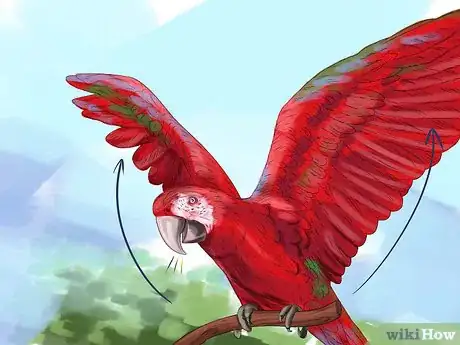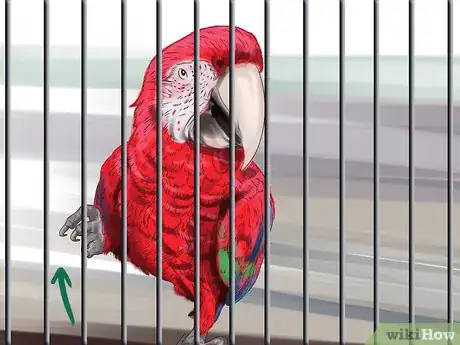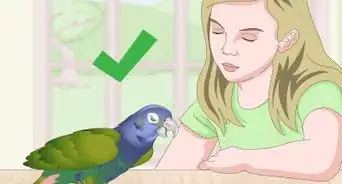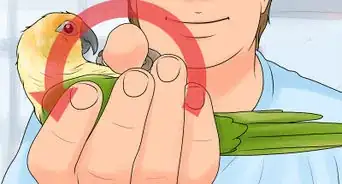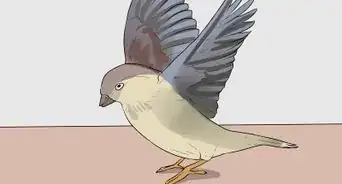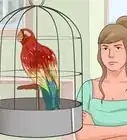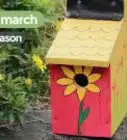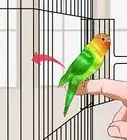This article was co-authored by Pippa Elliott, MRCVS. Dr. Elliott, BVMS, MRCVS is a veterinarian with over 30 years of experience in veterinary surgery and companion animal practice. She graduated from the University of Glasgow in 1987 with a degree in veterinary medicine and surgery. She has worked at the same animal clinic in her hometown for over 20 years.
There are 8 references cited in this article, which can be found at the bottom of the page.
This article has been viewed 38,890 times.
Greenwing Macaws make fun, interactive, and loving pets. Because they are highly intelligent and social animals, macaws need plenty of exercise and stimulation. It's essential to create a positive and healthy relationship with your bird so that it feels like a member of the family. Providing a bird with a safe environment and trusting caretakers will help prevent bites and aggression, and give you more time to focus on the fun tasks of teaching your bird linguistic skills and a variety of tricks.
Steps
Fostering A Positive Relationship
-
1Gain your bird's trust. Spend a few days getting to know your macaw before beginning training. Physical affection isn't always the best way to go early on. Engage in low-stress, low-demand activities such as talking to your bird in a calm, soft voice. [1]
-
2Offer your bird treats on a spoon. It's great to give your bird a treat after it becomes more comfortable around you, but a biting bird may snatch treats away or even bite the hand that feeds it. If you think your macaw might do this, offer the treat on a long, flat object like a wooden spoon to keep your hand at a distance. Don't force the treat acceptance process – wait for your bird to come to you. Once a treat has been accepted, you can gently pet your bird on the chest.
- The best treats for macaws are nuts, such as macadamias, pecans, filberts, almonds, and walnuts. [2]
Advertisement -
3Provide your bird with a large cage. Macaws are big birds that need a substantial amount of exercise. Purchase a cage that provides ample space for toys, multiple perches, and food dishes, while still leaving enough room for your bird to move freely.
- Bring elements of the natural world into your cage. Try making perches out of sticks and placing small branches with leaves in the cage to make your bird feel more at home.
- Give your bird time out of the cage, too. This will let the macaw get much needed exercise and stimulation. Place perches around the house, especially in areas where you or family members tend to hang out, so that your bird can feel socially engaged.[3]
-
4Feed your bird a balanced diet. A balanced diet consists of 85% pellets, 5% varied seeds, and 10% fresh fruits and veggies. Parrot mixes are available that combine formulated foods, seeds, dried foods and nuts. Additional supplements, such as fresh fruits, vegetables, and cooked chicken and meat, are good ways to give your bird extra vitamins and protein. [4]
- Be sure to provide your bird fresh drinking water everyday.
Training Your Bird
-
1Associate your hands with positive behaviors. Some people make the initial mistake of using their hands to shoo away or throw objects at their bird as a way to punish bad behavior. This makes it hard for your bird to know whether your hands are going to be used for a positive activity, such as petting or holding, or a negative one. *[5]
- For the first few days, use a wooden stick or a perch to pick up your bird instead of your hands. When your bird starts to feel more comfortable around you, switch to picking it up with your hand and placing it on your finger.
-
2Teach your bird to step up. Getting your bird to step up onto your hand is essential for any further training. Go slow, and be sure to smile and make eye contact while teaching your bird to step up. Macaws can read your body language, and will know if you are stressed out or frustrated.
- Start by putting a treat in one hand and put the other close to the bird. The bird will likely go for the treat. Give the treat and offer praise. Then, try again, this time asking your bird to step up. Repeat this process until your bird is comfortable enough to step up. Once the bird steps up with one foot, continue until it begins to use both feet.
-
3Implement safe zones. Once you've started picking up your bird with your hands, it's important to teach it some boundaries. Otherwise, you run the risk of letting your bird fly recklessly around the house, which can result in injury or escape.
- Start by taking your bird out of its cage. Whenever the bird attempts to fly away, pick it up gently and place it on either your shoulder, hand, or the outside of the cage. This lets the bird know that these are acceptable landing zones.
- Once your bird becomes familiar with its safe landing zones, let it fly a bit more freely around the house. Be sure to monitor where your bird lands. If it does not land in a prescribed safe zone, continue to replace it on your hand, shoulder, or the cage until it no longer lands on unwanted places.[6]
-
4Always use positive reinforcement. Never hit your bird or use any kind of physical punishment, as this will immediately break the trust. Instead, offer treats and praise for positive behavior. If your bird misbehaves, simply say nothing and do not give a treat. [7]
Reading Your Bird's Body Language
-
1Listen for beak clicking. If your bird clicks its beak several times in a row, you should take this as a sign that your bird is either feeling defensive, aggressive, or does not want to be handled. Often beak clicking is accompanied by raising of a foot or neck stretching. Be mindful of your bird's behavior. Attempting to play with your bird at this time might result in a bite.
- Tongue clicking, on the other hand, is a sign that your bird wants to play. Learn the difference between beak and tongue clicking and respond appropriately. [8]
-
2Look for eye pinning. Flashing eyes are a potential signal that something is wrong. Eye pinning could mean that your bird is excited, but it often forewarns anger or aggression. When you notice your birds' eyes flashing, look for sources of distress in the immediate environment, and do not attempt to handle your bird to avoid biting.[9]
-
3Don't handle a growling bird. Growling is a bird's vocal way of telling you that they do not want to be touched. If a bird is feeling aggressive, growling is often coupled with dilated pupils and raised feathers. Retreat and give your bird some time to calm down.
-
4See if your macaw is hanging on the cage bars or raising his foot. This is a sign that he wants to come out, so take advantage of it! Open the cage door, and offer your arm to him, and say "step up" or "up". Make sure you yourself aren't nervous, because your macaw can tell. Make eye contact and he'll be less likely to bite. If he lunges at your arm, tell him firmly "no" and close the door. This will teach him that he can't come out of the cage unless he steps up onto your arm.
Warnings
- If your bird does bite, know how to react. Blow in its face to distract from biting, or put the bird on the floor, where it may feel more secure.⧼thumbs_response⧽
- If you don't know what you are doing, a macaw bite can be so serious it could bite your finger so badly or hand that you will need medical attention. Use your arm when you can, but not your shoulder either because he can do serious damage to your face.⧼thumbs_response⧽
Things You'll Need
- Cage
- Treats
- A perch in a quiet room
References
- ↑ https://www.beautyofbirds.com/biting.html
- ↑ http://animal-world.com/encyclo/birds/macaws/MacawProfile.htm#MacawTraining
- ↑ https://www.beautyofbirds.com/keepyourpetbirdhappy.html
- ↑ http://animal-world.com/encyclo/birds/macaws/MacawProfile.htm#MacawTraining
- ↑ https://www.beautyofbirds.com/biting.html
- ↑ https://www.beautyofbirds.com/taming.html
- ↑ https://pethelpful.com/birds/All-About-Macaws
- ↑ http://www.birdsnways.com/wisdom/ww15eii.htm
- ↑ https://www.beautyofbirds.com/communicatewithyourbirds.html
About This Article
If you have a greenwing Macaw that likes to bite, discourage this behavior by making sure your bird only associates your hands with positive things, like treats and petting. You should also build trust with your bird by talking to it in a calm, soft voice and feeding it treats with your hands or with a long wooden spoon to prevent biting. Because Macaws can read body language and will know if you're upset, make sure to smile, maintain eye contact, and offer lots of positive reinforcement, too. Once you've built trust with your bird, make sure it's getting enough physical, mental, and social stimulation by letting it out of its cage sometimes and teaching it tricks, like how to step up onto your hand. For more advice from our Veterinary co-author, including how to read your greenwing Macaw's body language to know when it might bite, keep reading!
